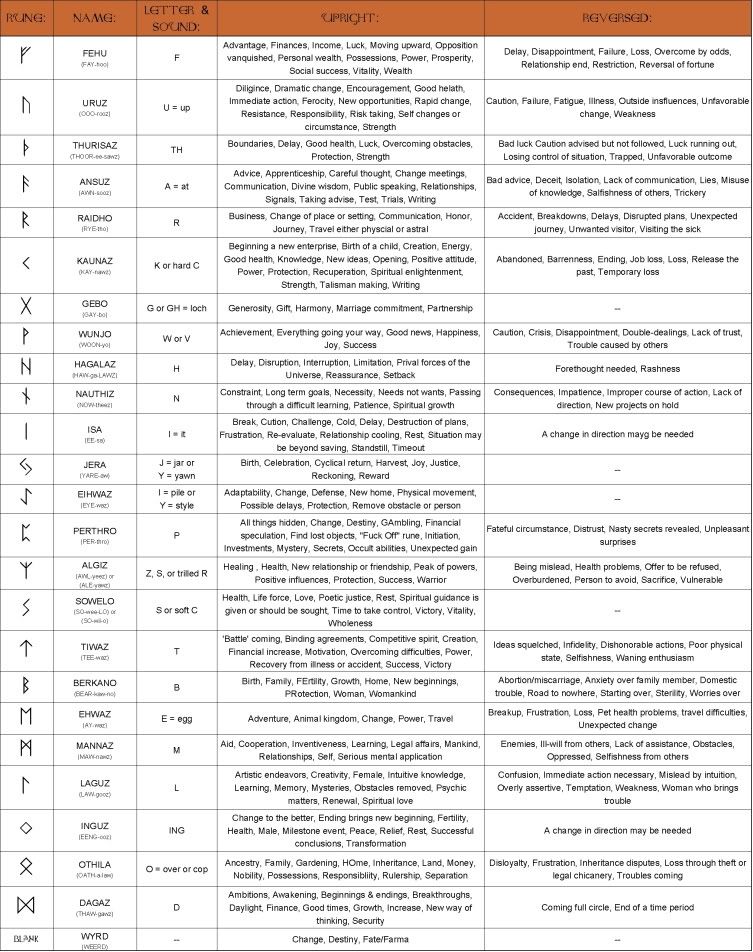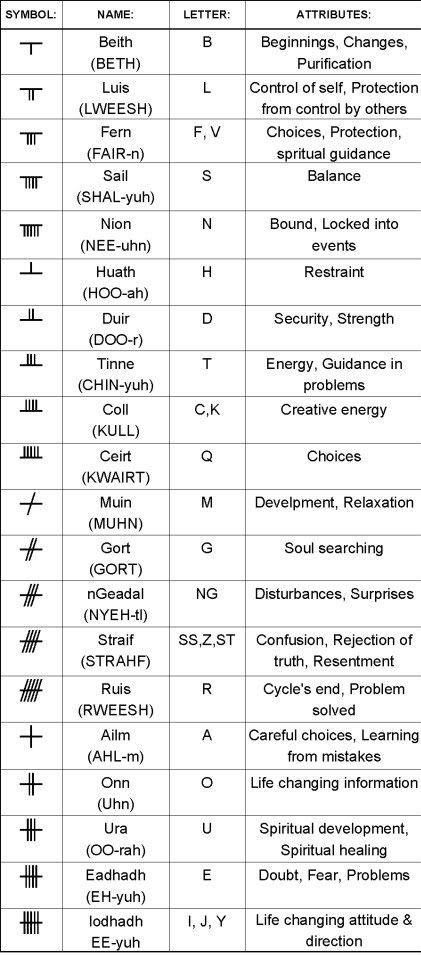I’ve
included here three Magickal Alphabets for you to work with. The fonts
can be found online in several different sites if you want to download
them to your computer for future usage. I’ve included the Elder Futhark
Runes, Ogham, and Theban/Witch’s/Honorian alphabets for working with our
bindrunes.
These
are relatively the most common in use. The Elder Futhark Runes and the
Ogham Staves (pronounced OH-gum) are also divination systems. It is
considered that these were originally divination systems and gradually
grew into a written language. As there was no written language prior to
this time, since each culture orally passed on their knowledge, this is
only conjecture.
Runes:
Runes
are an ancient alphabet form that dates back from the 4th century
through the 10th century and was, and still is, used for divination,
writing, and Magick. Runes were used by many different peoples during
many different time periods. The early Celts and their priests, the
Druids, used what is called the "Ogam Bethluisnion" (pronounced OH-gum
beth-LWEESH-NEE-uhn) form of Runic writing. But they are not “runes”, as
runes are only Germanic, Scandinavian and English. There are several
divisions of Runic alphabets: Anglo-Saxon, usually referred to as Elder
or Younger "Futhorc" or "Futhark", and the Germanic, and Scandinavian
Runic alphabet forms.
An
ancient meaning of Rune is "to whisper". The most common method of
reading the stones is to "cast" them and then interpret the message they
give. A reversed Rune alters it's meaning, for example "Fehu" right
side up refers to material gain but inverted it is interpreted as
poverty. The term for a reversed stone is called a merkstave which
loosely translates to “dark meaning“.
The
Runes are divided into three groups of eight called an Aett (pronounced
“ate). Each Aett is named for a Norse God: Frey, Hagel and Tyr. The
first, Frey’s Aett, consist of the secrets of creation and the sequence
of events that occurred when time began. The Runes is this set are:
Fehu, Uruz, Thurisaz, Ansuz, Raidho, Kaunaz, Gebo, Wunjo. The second,
Hagel’s Aett, contain the dark secrets of fate that can make their
presence felt. The Runes in this set are: Hagalaz, Nauthiz, Isa, Jera,
Eihwaz, Pertho, Algiz, Sowelo. The third, Tyr’s Aett, refers to humans
and the earthly, material plane. The Runes in this set are: Tiwaz,
Berkana, Ehwaz, Mannaz, laguz, Inguz, Othila, Dagaz. The blank Rune,
Wyrd, is included in this last set.
In
many modern Rune sets there is a blank Rune called "Wyrd". This is a
modern day creation that many believe should not be used. (It‘s your
choice to decide). Its concept is that things are in the hands of the
“Fates” and are beyond your knowing at the time.
There
are many Rune Stone sets to be found commercially or made by the
Witch’s own hand. The most powerful, of course, are those made by the
Witch from a natural material such as rock, gemstone or wood.

Image 3: Rune Table
Ogham:
This
alphabet is thought to be named for the God Ogam (pronounced O-gum).
The various names for this alphabet are: Ogam, Ogham (O-um), Beth Luis
Fearn (beth-LWEESH-FAIR-n) and Beth Luis Nion (beth-LWEESH-NEE-uhn).
The latter two are derived from the first, second and third letters and
the first, second and fifth letters respectively.
Each
of the letters are named for trees, but may have numerous other
associations. The letters are linked by a line representing the trunk of
the tree and the lines are the branches. Inscriptions were written
vertically top to bottom and manuscripts were written horizontally left
to right. The Eite (feather) is used at the beginning of a sentence and
the Eite thuathail (reversed feather) is used at the end of a sentence.
(Pronunciations eite = ate, thuathail = too-AW-hill).


Image 4: Ogham Table
Theban/Witch’s/Honorian:
This
alphabet is reputed to have been invented by Honorius of Thebes. It is
often referred to as the “Runes of Honorius”, the “Theban Alphabet” or
the “Witch’s Alphabet”. Its supposed first appearance was in Cornelius
Agrippa’s book De Occulta Philosophia (The Book of Occult Philosophy),
Book III, Chapter XXIX which was published in Latin in 1533. In his
book, Agrippa mentions that this alphabet was attributed to Honorius by
the medieval magician Petrus de Apono (1250-1316). Later, Francis
Barrett, an English author on magic reproduced the Theban Alphabet in
Book II, Part I, Chapter XIV of his publication The Magus.
This
alphabet does not have a J, U or W. But, in place of these the I and U
are used, but dots are placed after each so as to delineate from the
others. The J & U each have one dot and the W has two dots:

This alphabet is great for inscribing candles, charms, talismans, etc..
The
following table includes all three alphabets so you can see how they
compare to the English alphabet. Because the Theban (Witch’s) alphabet
has 26 letters just as the English alphabet, it is usually the easiest
for writing sentences and spells, as well as excellent for seals. Runes
are best for bindrunes. The Ogham staves are very good for surrounding
seals and single letters on talismans and amulets.

Image 5: Magickal Alphabet Table
There
are many, many alphabets that can be used. The Hebrew alphabet is used
for Kabbalah works. Egyptian hieroglyphs are great for personalized
amulets and talismans. Dragon runes are a great addition when writing
Dragon Magick spells or making talismans with specific Dragon intents.
As
you progress in making seals, sigils, and bindrunes you will discover
many other aspects that will greatly increase their energies. You’ll
find yourself making talismans for your car, your purse or wallet, and
uses for seals around your home. The ideas will be endless and no idea
is too trivial. If you think of it, then its important to you
subconsciously, if not consciously.
So,
keep these correspondences. In time you’ll learn them so that when a
seal, or sigil, or bindrune is necessary you’ll automatically know what
is needed. But don’t worry it to death! Just take your time and enjoy
it.
************

No comments:
Post a Comment